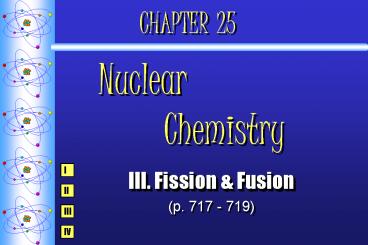CHAPTER 25 Nuclear Chemistry - PowerPoint PPT Presentation
1 / 16
Title:
CHAPTER 25 Nuclear Chemistry
Description:
Nuclear Chemistry I III. Fission & Fusion (p. 717 - 719) II III IV A. F ission Nuclear Reactions produce exponentially more energy than chemical reactions. – PowerPoint PPT presentation
Number of Views:118
Avg rating:3.0/5.0
Title: CHAPTER 25 Nuclear Chemistry
1
CHAPTER 25 Nuclear Chemistry
I
- III. Fission Fusion
- (p. 717 - 719)
II
III
IV
2
A. F ission
- Nuclear Reactions produce exponentially more
energy than chemical reactions. (nuclear bomb vs.
dynamite chemical bombs) - Fission is splitting
- a nucleus into two
- or more smaller nuclei
- 1 g of 235U 3 tons of coal
3
A. F ission
- chain reaction - self-propagating reaction
- critical mass - mass required to sustain a
chain reaction - Super-critical is
- when chain rxn
- goes too fast
- MELTDOWN
4
B. Fusion
- combining of two nuclei to form one nucleus of
larger mass - thermonuclear reaction requires temp of
40,000,000 K to sustain - 1 g of fusion fuel 20 tons of coal
- occurs naturally in stars
5
C. Fission vs. Fusion
FISSION
FUSION
- 235U is limited
- danger of meltdown
- toxic waste
- thermal pollution
- Heavy hydrogen fuel is abundant
- no danger of meltdown
- no toxic waste
- not yet sustainable
6
CHAPTER 25 Nuclear Chemistry
I
- IV. Applications
II
III
IV
7
A. Nuclear Power
- Fission Reactors
8
A. Nuclear Power
- Fission Reactors
9
A. Nuclear Power
- Fusion Reactors (not yet sustainable)
10
A. Nuclear Power
- Fusion Reactors (not yet sustainable)
National Spherical Torus Experiment
Tokamak Fusion Test Reactor Princeton University
11
B. Synthetic Elements
- Transuranium Elements
- elements with atomic s above 92
- synthetically produced in nuclear reactors and
accelerators - most decay very rapidly
12
C. Radioactive Dating
- half-life measurements of radioactive elements
are used to determine the age of an object - decay rate and amount of radioactive material
remaining indicate the age - EX 14C can date ages of up to 40,000
years 238U and 40K - over 300,000 years old
13
PET Scan
- Positron Emission Topography
- Inject or swallow a sugar with a radioactive tag
that emits positron, which are measured by a
scanner
14
D. Nuclear Medicine
- Radioisotope Tracers (bonded to sugars, proteins,
or medicines) - absorbed by specific organs and used to diagnose
diseases - Radiation Treatment
- larger doses are used to kill cancerous cells
in targeted organs - internal or external radiation source
15
E. Nuclear Weapons
- Atomic Bomb
- chemical explosion is used to form a critical
mass of 235U or 239Pu - fission develops into an uncontrolled chain
reaction - Hydrogen Bomb
- chemical explosion ? fission ? fusion
- fusion increases the fission rate
- more powerful than the atomic bomb
16
F. Others
- Food Irradiation
- ? radiation is used to kill bacteria
- Radioactive Tracers
- explore chemical pathways
- trace water flow
- study plant growth, photosynthesis
- Consumer Products
- ionizing smoke detectors - 241Am

